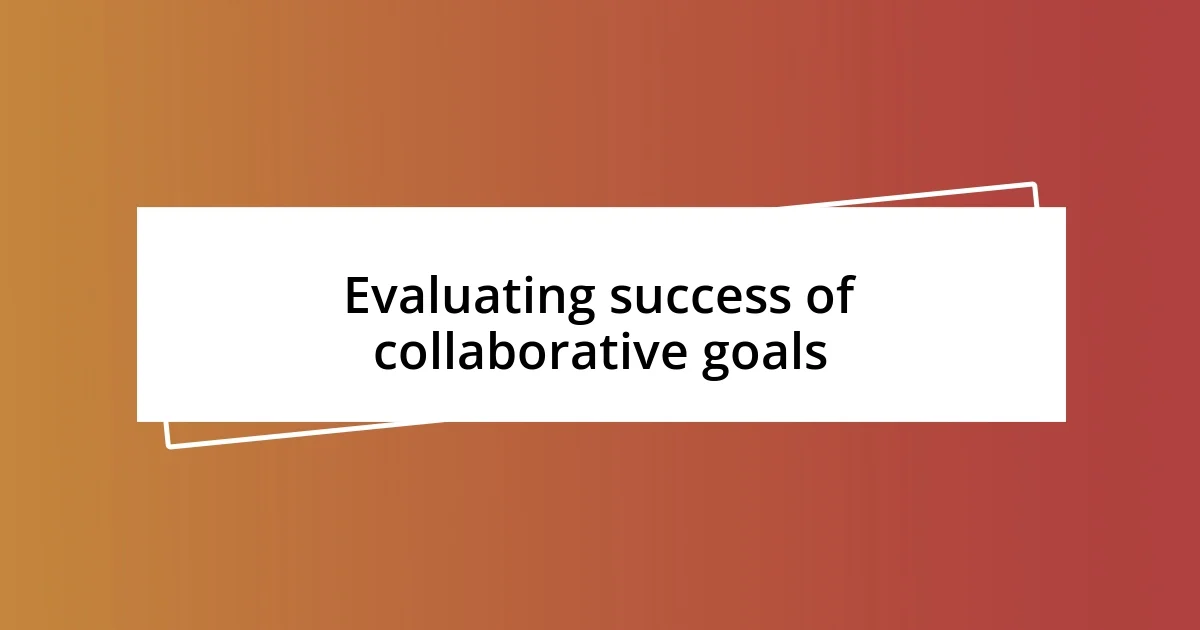Key takeaways:
- Setting collaborative goals fosters shared accountability, enhances creativity, and boosts motivation among team members.
- Overcoming collaboration challenges requires clear roles, open dialogue, celebration of small wins, flexibility, and trust-building.
- Evaluating success includes using feedback loops, reflecting on emotional impacts, and celebrating achievements beyond quantitative metrics.

Benefits of setting collaborative goals
One of the most rewarding aspects of setting collaborative goals is the sense of shared accountability it fosters among team members. I remember a project where we aimed to enhance our customer service experience. It was exciting to witness how, as we tackled challenges together, we not only improved our performance but also built stronger relationships along the way. Hasn’t it ever struck you how working towards a common objective can deepen connections?
Moreover, collaborative goals often lead to enhanced creativity and innovation. When I worked with a diverse team on a marketing campaign, each member brought their unique perspectives into the mix. This collaboration sparked ideas that none of us would have generated alone. Aren’t those moments of collective brainstorming some of the most exhilarating parts of teamwork?
Another significant benefit is the increased motivation that comes with collaboration. I recall a time when our team was struggling to stay engaged on a long-term project. Once we set clear, collaborative goals, our enthusiasm surged. It’s incredible to think about how a well-defined shared purpose can reinvigorate a whole group’s energy. How often do we underestimate the power of collective ambition?

Overcoming challenges in collaboration
Collaboration can be a double-edged sword; while it brings people together, it often surfaces challenges that can be tricky to navigate. In one project, where different personalities clashed, I noticed how misunderstandings could quickly spiral into frustration. I learned that addressing issues directly and fostering open communication was key to transforming tension into productive dialogue.
To successfully overcome hurdles in collaboration, I’ve discovered some effective strategies that make a significant difference:
- Establish Clear Roles: Defining each person’s responsibilities can eliminate confusion and enhance accountability.
- Encourage Open Dialogue: Creating a safe space for honest conversation helps to address concerns before they escalate.
- Celebrate Small Wins: Acknowledging progress fosters a positive atmosphere and keeps morale high.
- Stay Flexible: Being ready to adapt helps the team pivot when unexpected challenges arise.
- Build Trust: Investing time in relationship-building pays off when conflicts arise, creating a supportive team dynamic.
These strategies have not only helped me in my experiences but also have been essential in strengthening the foundation of collaborative efforts within the team.

Evaluating success of collaborative goals
Evaluating the success of collaborative goals can feel a bit like piecing together a puzzle. I remember when my team completed a project we had worked on for months. We gathered data to assess whether we met our targets and exceeded our customers’ expectations. It was both exciting and nerve-wracking to see the real results. Have you ever felt that mix of anticipation and apprehension about evaluation?
One method I found particularly effective is using a feedback loop. After achieving a goal, I’d often sit down with my team to discuss what went well and what didn’t. We would ask questions like, “What strategies did we implement that truly resonated with our objectives?” and “Where can we improve next time?” This reflective practice not only helped us measure our success but also built a culture of continuous improvement. Isn’t it fascinating how looking back can pave the way for future achievements?
Success isn’t just about numbers; it’s also about the impact we make as a team. I’ve come to realize that the emotional response from team members, such as pride or excitement upon achieving a goal, serves as a qualitative measure of our success. Reflecting on those moments, like the joy when we received positive client feedback, fills me with warmth, reminding me that the true essence of our collaborative journey goes beyond metrics. How often do we take a moment to celebrate the feelings along with the outcomes?













